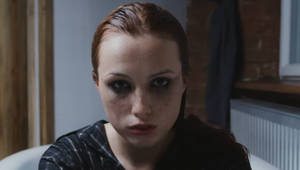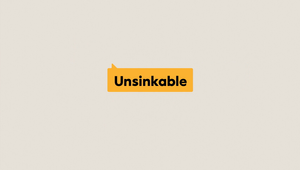
Why This Canadian Broadcaster Invited Citizens to ‘Get Curious’

If you ask a Canadian what they know the CBC for, the answer is usually its news and public affairs programmes. And, there’s a good reason for this. Across multiple formats, the work is consistent, strong and a reliable source of information, regardless of who you are, or where you live in Canada.
But, the CBC is so much more than just that. From TV to podcasts to radio, the broadcaster’s programming is as diverse as the people of Canada, which is exactly the theme of its recent ‘Get Curious’ campaign.
Created in collaboration with Juniper Park\TBWA (JP\TBWA), the two used a modern and bold tone to emphasise how the CBC encourages the natural curiosity of Canadians. Across OOH, OLV, TV, digital, social and search, the joint creative teams wrote over 100 content-specific lines sharing fun facts and cool stats - all of which were rooted deeply in Canadian truths, and encouraged viewers with piqued interest to learn more.
To learn more about just what it took to bring this to life, LBB’s Josh Neufeldt sat down with Neil Walker-Wells, executive creative director at JP\TBWA, as well as Munro Cullen, senior creative director at CBC for a chat.
LBB> What was the brief for this campaign, how did this partnership come to pass, and what immediate ideas came to mind?
Munro> We wanted to build on last year’s ‘It’s a Canada Thing’ refreshed brand identity and campaign, for which we also closely collaborated with JP\TBWA. However, this time, our teams were tasked to create awareness and recognition for the CBC brand, with a focus on our entertainment offering aimed at Canadian audiences, especially millennials.
This really is a story of two creative agencies and two creative directors working together. So to answer the question of why we chose to work together; it’s really about the people and the experience. JP\TBWA has a large amount of experience working with larger, established institutions, which is what we needed, and CBC is a great legacy brand (and we also have an exceptional in-house creative team).
We were looking for partners who are great collaborators, and JP\TBWA are great partners.
Neil> The modern Canadian entertainment audience currently engages with news and entertainment through subscription video and other digital channels. So, we needed to open up the consideration space to include CBC, to get all the wonderful content that Canadians weren’t maybe aware of in front of people. But, it’s a tough ask - we’re all stuck in our own machinelike behaviour patterns and have our comfortable entertainment go-tos.
When the brief hit the table, the immediate idea and instinct was to get together with Munro and his creative team to a one plus one equals three challenge. We’ve got a great relationship, and I was keen to put our heads and creative teams together to make the most of this.
LBB> Why was the theme of ‘Get Curious’ right for the moment, and where did you get started with this, creatively speaking?
Munro> We want to be a part of Canadians’ lives, and in our world of increased competition and declining consideration, we want to stand apart and engage an audience that may not have grown up with us or are not familiar with our entertainment programming.
Being curious seems to be in the zeitgeist and has its rewards when you discover something new that feeds your interest. CBC has incredible content that a lot of people are unaware of, and we believe that engaged folks out there will be interested in discovering - feeding their curious habits.
In other words, we know there’s a bunch of curious people out there, and we want to be friends.
Neil> When we launched the brand refresh and ‘It’s a Canada Thing’ last year, we wanted the brand to be a more contemporary reflection of the country we live in today. To do so, we tapped into the current modern makeup of Canada, its people, its diversity, and moved away from the more traditional look and feel. ‘Get Curious’ is definitely a natural extension of that, and is meant to connect with modern Canada and modern behaviour, to inspire people to explore, and to deviate from the norm.
LBB> It’s noted that TBWA’s ‘Edges’ served as inspiration throughout the creative development process. Tell us more about this! What is it, and how did it factor in?
Neil> At TBWA, we have an always-on cultural intelligence unit called Backslash, which is the brain behind Edges. We have spotters all over the globe looking out for trends and behaviours which offer a future-focused look at cultural shifts, which, in turn, helps us ensure that the brands we work on have a meaningful place and share in the world. This was a huge help with the ‘Curious’ work, as we weren’t aiming to connect with people through content directly, but through what drives them to consume content.
LBB> Why was creating a bold, modern and fun tone across the creative right for the brand, and how did you execute this?
Munro> The short answer is that we know we’re fun and we also know we’re bold. We just don’t say it enough!
CBC’s programming teams are producing and offering incredible entertainment every day, and we want the world to know about it. From comedies to docs to dramas on CBC Gem, plus podcasts and music, if you’re a curious person, we know you’ll find something you’ll enjoy.
Neil> We had a lot of fun making the campaign with Munro and the CBC team. We’d visit each other’s spaces, stick work up, take it down, and have good old-fashioned creative sessions. And look, ultimately CBC is made to entertain, so the work should be entertaining in order to compel change. Munro’s team was invaluable in making sure we captured the essence of the brand, and helped make sure the tone was applicable for every format and type of content.
LBB> Let’s talk more about the creative itself. You wrote over 100 content-specific lines to encourage Canadians’ natural curiosity. What was this process like? And do you have any particular favourites?
Neil> We watched, listened and learned a lot. Shows, docs, podcasts, news footage, you name it. We really dove into the content. I think our teams would do quite well in the entertainment section in a pub quiz right now.
Munro> Out of the 100-plus lines that were drafted, around 35 were used for OOH and video. The creative process, like most creative processes, was challenging and fun. Throwing everything at the wall and seeing if it stuck. ‘Did it make sense?’, ‘Did it speak to the content?’, ‘Did it provoke?’. These were our questions, and I feel we succeeded in answering them.
My favourite lines are ‘Is cake better than sex?’, and ‘Why is nature so fricking awesome?’. The latter is a nod to one of CBC’s less-known comedies - the absurdist and joyful ‘Frick, I Love Nature’. It’s a gem of a show that we think audiences should know about. And the cake line is just a really great question.

LBB> Building on this, how did you ensure each would touch on deeply Canadian truths?
Munro> I don't think we were actually looking for deeply Canadian truths - that wasn’t the lens. If it was, we'd probably get lost in maple syrup and Canadian exceptionalism which is not the path we want to head down.
Instead, we wanted to focus on the content and ask curious questions. The answers to these questions, for the most part, happen to be in Canada, but more importantly, can be found within CBC.
Ultimately, we wanted to position CBC’s breadth of entertainment programming in a way that is unexpected, surprising and fresh. The lines were drafted based on a selection of titles across CBC Gem, CBC Music and CBC Podcasts that may not be immediately known or associated with CBC, and narrowed down to the most original and provocative - the ones that would most likely garner attention and peak interest.
LBB> With that in mind, what should more Canadians know about the CBC’s offerings?
Munro> First, we want Canadians to know that we’re entertaining and they should consider CBC when they are looking for something to watch or listen to.
And, as I said before, we have a lot to offer. From documentaries about bug sex and eating insects to podcasts uncovering the real stories behind cults and crypto, music from underrepresented voices across Canada to unexpected and hilarious comedies - we offer a wide range of entertainment that will surprise you.
LBB> Moving back to the creative, we must talk about the spot! What was the writing process like for this, and how did it come together in the edit?
Neil> As mentioned earlier we spent a lot of time together in rooms. With two teams, kicking ideas around, many died, some lived, but ultimately we came together to deliver the idea of using the content to front the campaign in a provocative, engaging manner that could be seen and understood anywhere in Canada.
Munro> We’re super proud of how this came together. The edit was done by the CBC team and is a combination of a video timeline being put together, and then a great animator bringing it to life.
As we’ve talked about, we have a lot of entertaining curiosities at CBC and the video challenge was, ‘How do we get them all into one spot?’. The answer is that you can’t… However, you can get the idea of all our content across with a mix of collage and video under the umbrella of a great script and strong art direction. It takes a village.
LBB> Outside of that, you also went to great lengths to ensure creative placement for OOH and other ads. How did you choose tactical spots across Canada, and specifically, what were you looking for in this selection process?
Neil> We worked with media to make sure the campaign was displayed at key points and moments - spots where people were either looking to be entertained (bored) or spaces that were contextually relevant to the content. As humans, we’re all naturally curious, and we aimed to trigger that instinct with the campaign.

LBB> What challenges have you faced during this project? How did you overcome them?
Neil> Creativity can be a very personal thing, and everyone has a different process. It’s never going to be 100% smooth sailing throughout with different opinions and ways of working, but I thought we managed to bring two creative departments together and manage all the dynamics of that really, really well. Lots of mutual respect, and definitely some laughs.
Munro> Echoing this, it really is a delicate balance managing between teams, different perspectives, and different ways of working. The key thing is to ensure that there is trust, and open and honest communication. (Plus good laughter. Lots of good laughter.)
LBB> What lessons have you learned from the making of this campaign?
Neil> Together, the work is better. Listen, get to know each other as humans, understand the motivations and personalities involved, as well as the pressures.
Munro> That being curious is exciting, and that being brave and bold is OK. Sometimes it feels like we are a little too cautious and, sometimes, staid when we’re speaking to audiences, but we can be fun. We surprised audiences with our approach. It’s a good lesson to meet the audience where they are.
LBB> Since launch, how have people responded?
Neil> I’ve seen quite a few people interact with the work in the wild, which is always a win!
Munro> Initial research has shown positive responses to the rebrand. But, we need to keep building on that momentum - our work isn’t done.
LBB> How does this campaign fit into CBC’s plans for 2024 and beyond?
Munro> We want to keep going with it. One thing we like about ‘Get Curious’ is the strength of the idea. We want to iterate and continue building it out - speaking to new audiences who are curious.
LBB> Finally, has this campaign inspired you to get curious?
Neil> For sure. I’d love to know who’s watching or listening to what on CBC right now, to be honest. Can we crystal ball that?
Munro> It really has. I am curious as to where we can take it, and what else we can do with the idea. Being curious has no limits.















